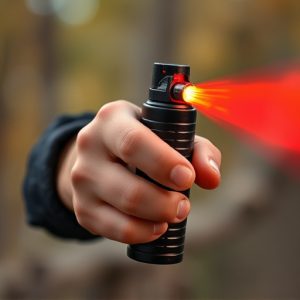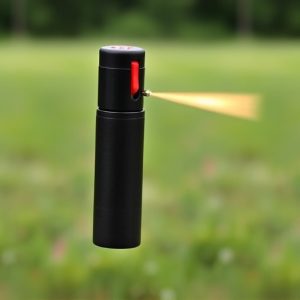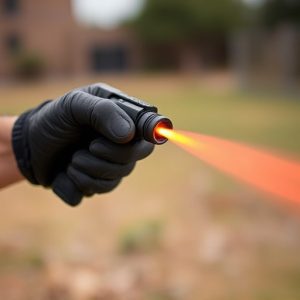Non-Lethal Pepper Spray Canisters: Effectiveness, Use & Safety
Non-lethal pepper spray defense canisters have emerged as a key tool for riot control and personal s…….
Non-lethal pepper spray defense canisters have emerged as a key tool for riot control and personal safety, utilizing capsaicin to temporarily incapacitate targets without causing lasting harm. Handheld and easily deployable, these devices are effective during civil disturbances, crowd control, and high-risk facility security. Proper training and safety protocols, including appropriate PPE, aim to maximize the benefits while minimizing risks associated with handling riot control sprays. Non-lethal pepper spray defense remains a valuable last-resort option for law enforcement and security personnel, contributing significantly to public order and safety.
“Uncovering the power of riot control inflammatory spray canisters, a non-lethal defense tool proven to de-escalate volatile situations. This comprehensive guide explores the science behind these effective devices, their diverse applications in law enforcement and security, and critical safety measures for handling. From understanding the active ingredients to best practices for deployment, discover how non-lethal pepper spray canisters serve as a vital tool in modern public safety protocols.”
- Understanding Non-Lethal Pepper Spray Canisters
- How Riot Control Sprays Work: The Science Behind the Effectiveness
- Applications and Use Cases in Law Enforcement and Security
- Safety Measures and Best Practices for Handling and Deployment
Understanding Non-Lethal Pepper Spray Canisters
Non-lethal pepper spray canisters have become a crucial tool in riot control and personal defense, offering an effective yet non-deadly option for law enforcement and individuals facing dangerous situations. This type of spray is designed to incapacitate or disorient the target without causing permanent harm, making it a game-changer in managing crowds and self-defense scenarios. The canisters contain capsaicin, the active ingredient found in chili peppers, which stimulates the body’s pain receptors, leading to temporary blindness, coughing, and difficulty breathing.
These spray devices are typically handheld and easily portable, allowing users to deploy them swiftly when faced with riots, violent protests, or threats of physical harm. The non-lethal nature of pepper spray makes it a preferred choice in situations where the use of deadly force might be controversial or inappropriate. With proper training and understanding of its capabilities and limitations, individuals can utilize non-lethal pepper spray defense as a strategic tool to protect themselves and others while minimizing potential injury.
How Riot Control Sprays Work: The Science Behind the Effectiveness
Riot control sprays, such as non-lethal pepper spray defense, work by employing chemical agents that cause a range of physical reactions in the target. These sprays typically contain capsaicin, the active ingredient found in chili peppers, which is irritant to the eyes, nose, throat, and respiratory system. Upon inhalation or contact with the skin, capsaicin binds to specific receptors, triggering a cascade of responses. The primary effects include teary eyes, difficulty breathing, coughing, and pain—all intended to incapacitate temporarily without causing permanent harm.
The science behind riot control sprays’ effectiveness lies in their ability to disrupt normal bodily functions quickly. The spray forms a thin, invisible layer on the skin and in the air, ensuring that even at close range, it can reach and affect multiple individuals simultaneously. This rapid response makes them valuable tools for law enforcement and security personnel in managing civil disturbances, providing a non-lethal means of defense and control in challenging situations.
Applications and Use Cases in Law Enforcement and Security
In the realm of law enforcement and security, riot control inflammatory spray canisters, commonly known as non-lethal pepper spray defense, serve as a versatile tool for managing various situations. These devices are deployed in scenarios ranging from crowd control during public protests to securing high-risk facilities. Police officers utilize them to quickly disperse aggressive crowds, providing time for the situation to de-escalate without resorting to lethal force.
Use cases span from riot gear for dealing with civil unrest to personal defense mechanisms for security personnel. The non-lethal spray is designed to cause temporary blindness, coughing, and breathing difficulties, effectively immobilizing individuals while ensuring their safety and that of the officers. This application has proven instrumental in maintaining public order and protecting both citizens and law enforcement officers from potential harm.
Safety Measures and Best Practices for Handling and Deployment
When handling a riot control inflammatory spray canister, safety is paramount. Law enforcement and security personnel should always wear appropriate personal protective equipment (PPE), including eye protection, respirators, and durable clothing to minimize exposure to spray. Training is crucial; understanding the canister’s range, wind dynamics, and de-escalation tactics ensures safe and effective deployment while mitigating risks to both officers and civilians.
Best practices involve aiming for the legs and lower torso, as this minimizes impact on eyes and breathing. Keep a safe distance, respecting the canister’s range limitations. In crowded or confined spaces, be especially cautious to prevent accidental inhalation by individuals nearby. After deployment, ensure proper disposal of empty canisters according to local regulations. Prioritize de-escalation strategies whenever possible, using non-lethal pepper spray as a last resort when necessary for crowd control and public safety.
Riot control inflammatory spray canisters, or non-lethal pepper spray defenses, have proven their effectiveness in various law enforcement and security applications. By understanding the science behind their operation and implementing proper safety measures, these tools can help maintain public order while minimizing harm. As society continues to evolve, so do the needs of security professionals, making ongoing research and responsible deployment paramount for ensuring a safe and secure environment.


